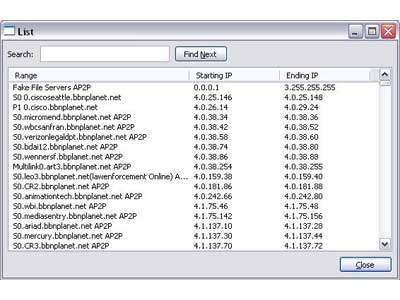
- Peerguardian 2018 update#
- Peerguardian 2018 software#
- Peerguardian 2018 code#
- Peerguardian 2018 plus#
It lets you configure the firewall for different zones, each containing a specific ruleset. The firewall, which runs as a daemon, is also found in Fedora and the CentOS RHEL derivative, as well as in the repositories of most common Linux derivatives.įirewalld supports IPv4 and IPv6 in particular, its zone model stands out.
Peerguardian 2018 software#
Although firewalld works with the netfilter system, the software is incompatible with the iptables control model. firewalldįirewalld has been the default firewall on Red Hat Enterprise Linux (RHEL) since version 7, replacing iptables in this distribution. Application filters and blacklists also boost security – as long as the admin maintains and updates them regularly. For example, log analyses of packet transfers help the admin set up an Intrusion Detection System (IDS) or Intrusion Prevention System (IPS). In contrast to a static firewall, not every modification should stop and restart the firewall while interrupting the Internet connection, which is the only way to implement appropriate rules for applications that require specific ports during operation.Īnother important evaluation criterion for firewalls is logging. Two of the most important things that professional firewalls need to support are the ability to handle IPv4 and IPv6 and the ability to adapt dynamically. The log window now gradually fills up with blocked IP addresses, the associated ports, and information about the type of connection ( Figure 2). Once the updates have been installed, the firewall is enabled by clicking on the Start button in the Control tab.
Peerguardian 2018 update#
On first use, you will want to update the lists by pressing the Update button in the Control tab then, track the update in a small log window, which you call with View | View pglcmd's log.
Peerguardian 2018 plus#
You can add more websites or areas to the list by pressing the green plus symbol below the blocklist. You can activate the blocklist update intervals as required by checking the address range to be blocked. At the top is an option to start the software at system boot and to update the blocklist automatically. Here, in the Whitelist area, you can enter addresses to be released. The ready-made blocklists are grouped in the Configure tab.

The program, which is distributed under the GNU GPL, initially comes up with an empty list area in the active Control tab of the dialog window showing the session log. PeerGuardian lets you block unwanted IP addresses quickly without the need for complex proxy server configuration in intranets. The GUI greatly simplifies the handling of blocklists.
Peerguardian 2018 code#
PeerGuardian's source code is available for DIY compilation, as well as from the repositories of some major Linux distributions. Not included in this review are configuration environments that are outdated (see the "Not in the Running" box).įigure 1: PeerGuardian blocks IP addresses or IP address ranges. I also looked at the PeerGuardian IP blocker, which is not a conventional firewall (see the "PeerGuardian" box). In this article, I review four such GUIs: firewalld, fwbuilder, Gufw, and Shorewall. Because of this lack of intuitiveness, running the packet filter at the command line can quickly cause damage by user error.įor this reason, many firewalls now have graphical user interfaces (GUIs), which makes this somewhat cumbersome task easier. Iptables does not make it easy for less experienced administrators to configure the firewall, so several distributions have their own tools. If you don't regularly use this process, you tend to forget quickly the necessary command-line parameters. However, configuring iptables is not very intuitive. Nftables is about to replace this system, but until then, iptables remains the configuration helper for the complicated netfilter system and is regarded as the default tool for Linux.

Firewalls under Linux are usually based on the kernel's netfilter system, which was introduced in 2001.


 0 kommentar(er)
0 kommentar(er)
